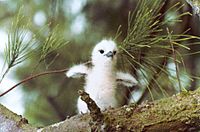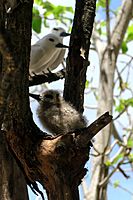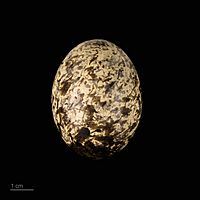White tern facts for kids
Quick facts for kids White tern |
|
|---|---|
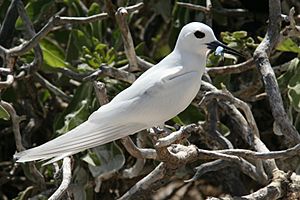 |
|
| A white tern on the French Frigate Shoals | |
| Conservation status | |
| Scientific classification | |
| Genus: |
Gygis
|
| Species: |
alba
|
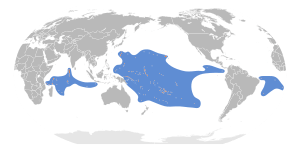 |
|
The white tern (Gygis alba) is a small seabird that lives in the tropical parts of the world's oceans. People sometimes call it the fairy tern, but this can be confusing. Another bird, Sternula nereis, also uses that name. Other names for the white tern are angel tern and white noddy. In Hawaiian, it's known as manu-o-Kū.
Contents
About the White Tern's Name
The white tern was first officially described in 1786. A Swedish scientist named Anders Sparrman gave it the scientific name Sterna alba. Later, in 1832, a German zoologist named Johann Georg Wagler created the group (genus) Gygis for this bird.
The name Gygis comes from an Ancient Greek word, guges, which was a mythical bird. The word alba is Latin for "white," which perfectly describes this bird's feathers.
White Tern Subspecies
The white tern has different types, called subspecies, that live in various parts of the world. They are:
- G. a. alba: Found on tropical islands in the southern Atlantic.
- G. a. candida: Lives from the Seychelles and Mascarene Islands to the central Pacific. This includes the southern Maldives.
- G. a. microrhyncha: Found in the Phoenix, Line, and Marquesas Islands.
- G. a. leucopes: Lives in the Pitcairn Islands.
Sometimes, G. a. microrhyncha is thought to be its own separate species, called the little white tern. Some scientists even think there might be three different species of white terns.
What White Terns Look Like
The white tern has a wingspan of about 76 to 87 centimeters (30 to 34 inches). It has beautiful white feathers all over its body. Its bill (beak) is long and black.
Where White Terns Live
White terns live in many places across the Pacific Ocean. You can find them from the coasts of Chile and Colombia to New Zealand. They also live along the eastern and southern coasts of Asia, from China to India, and in the Indian Ocean islands. They are even found off the coast of South Africa.
Sometimes, they are seen in Japan, Madagascar, Mexico, and on some islands in the Atlantic Ocean. These birds are pelagic, meaning they live mostly over the open ocean. During their breeding season, they move closer to wooded coastal areas. They often nest on coral islands, usually in trees with small branches. They can also nest on rocky ledges or human-made structures.
-
White tern parents near their chick in Cousin Island, Seychelles.
White Tern Behavior and Life Cycle
White terns are special because they lay their single egg on bare, thin branches. They find a small fork or dip in the branch and place the egg there without building a nest. This is very unusual for terns, as most terns build nests on the ground. Even other tree-nesting birds, like the black noddy, build a nest.
Scientists think that not building a nest helps the white tern avoid parasites. Parasites can sometimes cause whole bird colonies to leave their homes. However, there are downsides to this behavior. Strong winds can easily knock eggs and chicks off the branches. If an egg is lost, the white tern quickly lays another one.
When white tern chicks hatch, their feet are very strong. This helps them hold on tightly to their risky nesting spot. White terns are known to live a long time. Some have been recorded living for 42 years! They eat small fish that they catch by diving into the water.
White Terns and People
For ancient Pacific navigators, the white tern was a very helpful bird. These birds usually stay within 45 kilometers (about 28 miles) of their home island. They also tend to return to their island at night. This made them useful for finding land.
People in Polynesia also used to catch these birds for food or to keep as pets.
The white tern, known as manu-o-Kū, became the official bird of Honolulu, Hawaiʻi, on April 2, 2007.
The white tern is not considered an endangered species. It lives in many places and has several large groups (colonies) around the world.
See also
 In Spanish: Gaviotín albo para niños
In Spanish: Gaviotín albo para niños



